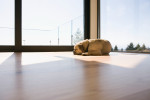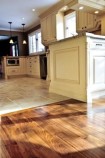WOOD FLOOR FACTS AND CARE INFORMATION
Wood floors are NOT impervious to day to day grit, food, spills, and water. Preventive maintenance like area rugs, floor protectors (on ALL furniture on your wood floors), and routine maintenance with proper hardwood floor cleaner should always be exercised. Improper products can contribute to additional wear, may VOID your warranty, and cause failure when recoating.
DO:
Place Protector pads on ALL furniture legs on wood floor
Place walk off mats and area rugs in high traffic areas (make sure they stay dry and are cleaned underneath often)
Perform routine maintenance as recommended by manufacturer, this should include sweeping, vacuuming (with a soft brush attachment) and/or dust mopping to remove dirt and grit. Keep this as a
regularly scheduled event, and stick to it. Always perform this process before and after a major event that involves a high volume of traffic on the floor.
Use the proper cleaning pad with the manufacturer recommended cleaning solution. The pad should be slightly damp and well rung out. Make sure ALWAYS to use a clean pad/cloth each time your start the
cleaning process. These pads can be washed after excessive buildup.
Keep high heel shoes in good repairs , as well as keeping your pets nails trimmed on a regular bases
DO NOT:
Use WET mops
Use ammonia
Use dust cleaners
Track dirt, clean immediately
Use other floor cleaning products
NEVER wax a urethane finish - NEVER !
MAINTENANCE TIPS
- Sweep your floors or use a dust mop daily, but do not use a household dust treatment, as this may cause your floors to become slick or dull the finish.
- Vacuum your floor regularly, as often as you would vacuum carpets.
- Clean your floor's coated surface with a lightly dampened cloth using a recommended cleaning product, and according to the manufacturer's directions for use.
- Never damp mop a wood floor. In all cases, use minimum water, because water causes deterioration of the wood itself, as well as the finish.
- Buy a "floor care kit" that your installer or flooring retailer recommends instead of counting on a home-made remedy of vinegar and water to clean your floors. Different finishes have different maintenance requirements, and it's best to follow professional advice in this area.
- Clean light stains by rubbing with a damp cloth
- Avoid using mops or cloths that leave excessive water on the floor. Never let a spill of water dry on the floor.
- Control humidity levels by use of a dehumidifier or humidifier. You may need to add portable units in some rooms.
- Have your floors recoated periodically as the finish shows wear.
- Do not clean your wood floors with water or water-based products on a regular schedule. Clean only when necessary and clean only the soiled areas.
SPECIFIC TYPES OF FINISHES
- NON-URETHANE: Low speed buffing with proper cleaning products and pad as recommended by manufacturer
- Use proper dust mop treatments
- White products require special procedures, making sure never to use water or petroleum based products
- Screening (light sanding by a flooring contractor) in addition to above procedures may be required
- Always follow manufacturers’ recommendations, and if in doubt, check with a local professional wood floor contractor
- SURFACE FINISHES (includes conversion varnish, moisture-cured urethane, oil-modified polyurethane, and water-based urethane)
- Always follow and use manufacturers suggest products and procedures, if product manufacturer is unknown, use GENERIC HARDWOOD FLOOR CLEANER available at local wood floor retail outlets.
- Warranties by most manufacturers are VOIDED if oil soap and products containing wax cleaners are used.
- Wipe and clean immediately all spills, and dirt tracking. Stubborn stains should be cleaned with proper cleaning solution as recommended by manufacturer, using a soft dampened cloth. For stubborn stains repeat using wood floor cleaner & soft cloth.
- NEVER use a wax or wax based products over surface finishes. This can be very dangerous!
- If your wood floor finish losses its luster, screening (light sanding) and recoating may be necessary. This should be done ONLY by a professional wood floor contractor.
HUMIDITY CONTROL
Choosing hardwood flooring is making an investment in a floor that will last 40 years or more, and you should protect that investment by installing humidity controls--a tool that helps the floor maintain a beautiful, trouble-free appearance.
Cracks and separations between boards
Nearly every floor gets some separation between boards. In winter, when homes are heated and the air is dry, wood flooring loses some of its moisture and therefore shrinks. When that happens, thin cracks appear between boards. This is normal, and acceptable, and you should not be calling the installers at the first sign of cracks. Once the indoor heat goes off in the spring, and the indoor environment regains moisture, most of these cracks will close up.
Cracks in winter - in the drier months - may easily develop to the thickness of a dime (1/32 inch) for solid 2 1/4-inch wide strip oak floors. Floors with light stained woods and naturally light woods like maple tend to show cracks more than darker finished floors.
Just add moisture to the air during dry periods. It's your choice - live with the cracks and wait until spring, or else add humidity by opening the dishwasher after a rinse cycle, switching off the bathroom fan or periodically boiling a pan of water. Better yet, install a humidifier.
Growing Boards
How much can temperature and humidity affect the dimensions of a hardwood floor? Studies show that on one 5-inch red oak plank board:
Within "normal living conditions" (say, an interior temperature of 70 degrees and a relative humidity of 40 percent), the board has a moisture content of 7.7 percent and is 5 inches wide.
If the relative humidity falls to 20 percent, the moisture content of the board will be 4.5 percent, and the same 5 inch board will shrink by .059 inches. Across 10 feet of flooring that could translate to as much as 1.4 inches of shrinkage.
If the humidity rises to 65 percent, the board's moisture content would be 12 percent and the same 5-inch board would expand by .O79 inches. Across 10 feet of flooring, this could translate to 1.9 inches of expansion.



